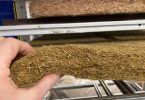Since the late 1800’s, houses have been built of straw. Contrary to nursery rhymes, these houses have proved sturdy and comfortable and not at all easy to blow down. In the last several years, as people have experimented with new and old building materials and looked for ways to halt rice field stubble burning, there has been a resurgence of homes built with straw. Unfortunately, there has been very little testing to determine the thermal performance of straw bale walls or to discover how these walls affect a home’s heating and cooling energy consumption. Reported R-values for straw bale walls range from R-17 to R-54, depending on the test procedure, the type of straw used and the type of straw bale wall system. This paper reports on a test set-up by the California Energy Commission (Commission) and conducted in a nationally accredited lab, Architectural Testing Inc. (ATI) in Fresno, California. The paper describes the tested straw bale wall assemblies, the testing process, and problems encountered in the construction and testing of the walls. The paper also gives a reasonable R-value to use in calculating thermal performance of straw bale houses and presents findings that show that straw bale construction can decrease the heating and cooling energy usage of a typical house by up to a third over conventional practice.
Authors: Commins, Tav R; Stone, Nehemiah I






